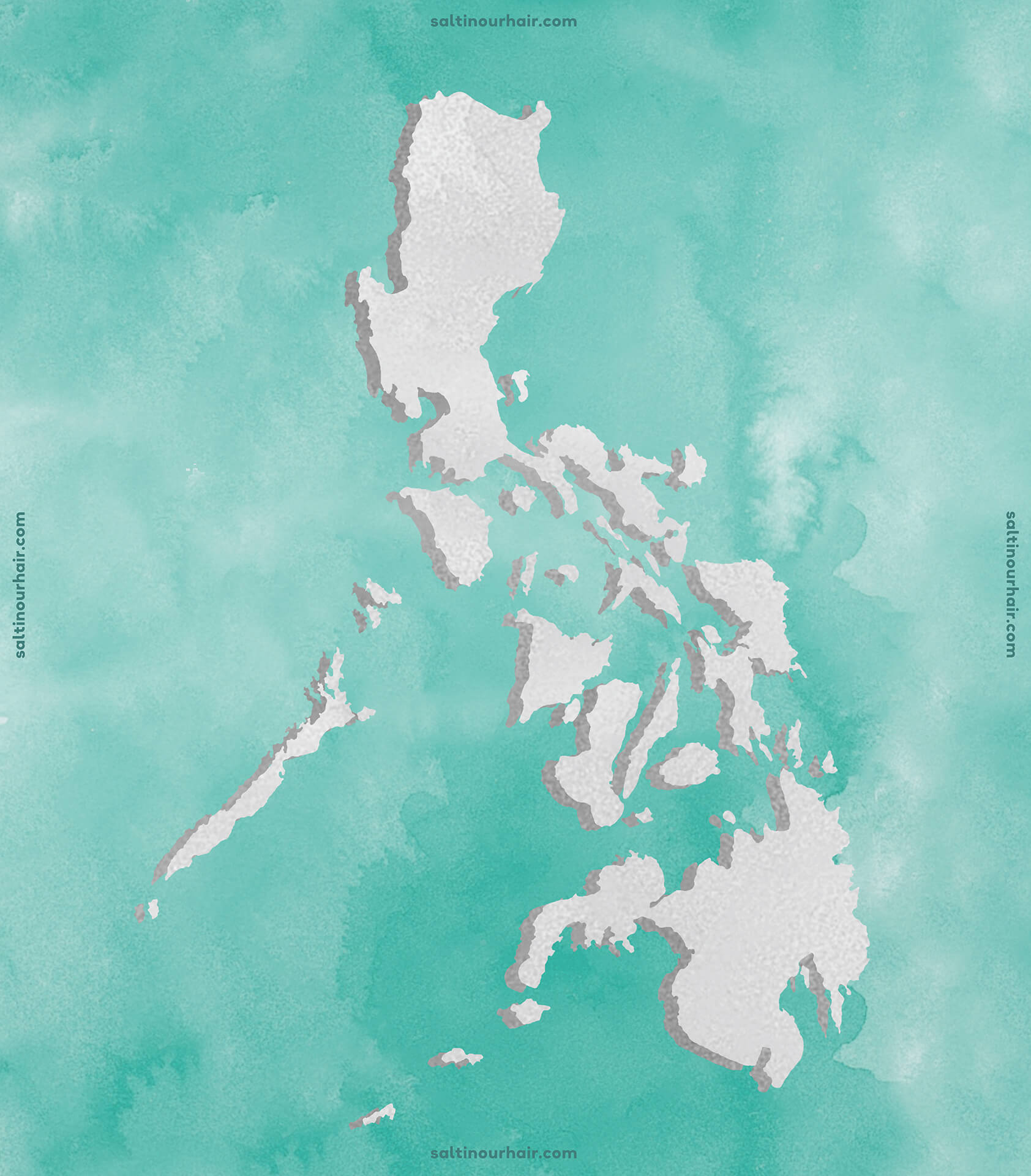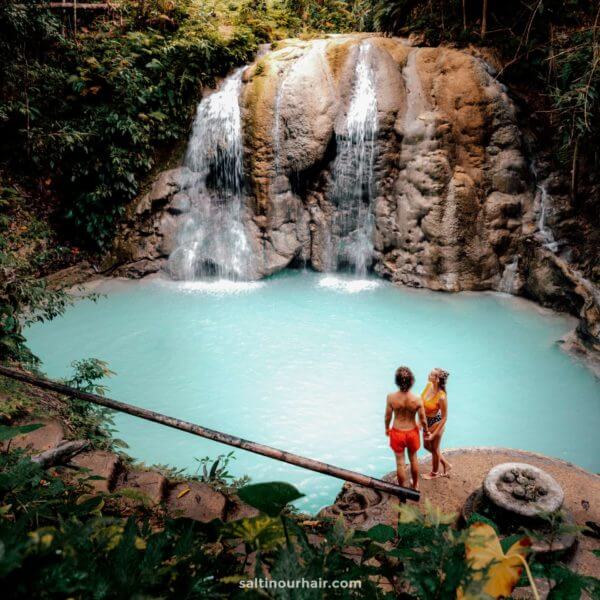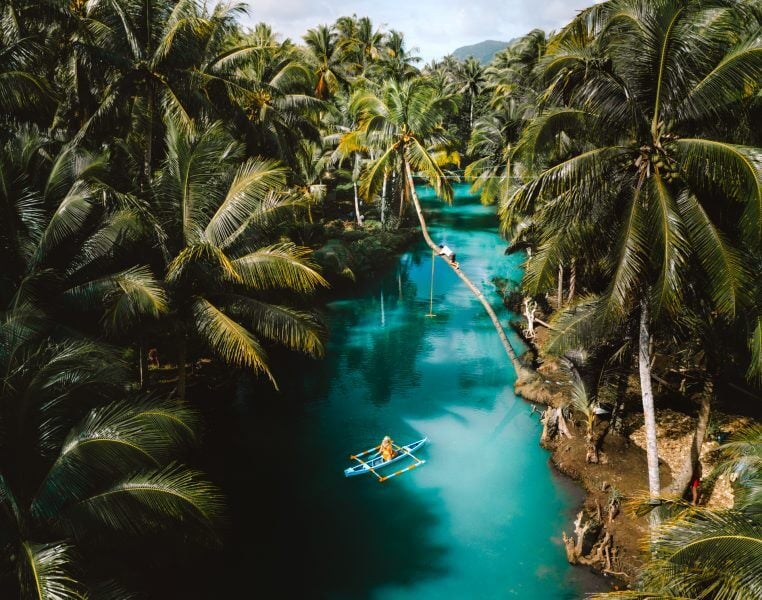Best time to visit Philippines
Southeast: Apr-Oct
How to get toEl Nido in Palawan
Best places to visit in Philippines

Map of Philippines
Weather in Philippines
The Philippines, a tropical haven, has two main seasons: the dry season from December to April and the wet season from May to November. However, some islands can follow the opposite season! As a whole, avoid the months of July to October, when typhoons may hit the country - nature's way of keeping things interesting!
- Find Hotels via Booking.com
- Find Hostels via Hostelworld
- Find a Rental Car via Sunny Cars
- Find Flights to Philippines via Skyscanner
- Get a Travel Insurance via Heymondo
- Book Tours & Attractions via GetYourGuide
- Book a Bus/Train/Transfer via 12Go
- Get a Visa via iVisa
- How to pack light for your trip
- How to plan your trip our tips
With 7631 islands, the Philippines has no shortage of outstanding places to visit, including enchanting rice terraces, thrilling hiking trails, renowned surfing spots, exceptional diving opportunities, and most notably, mesmerizing tropical beaches filled with palm trees, pristine white sand, and vibrant blue waters.
Few island getaways can rival the affordability and allure of the Philippines! While luxurious experiences are available, if you’re on a budget, expect to spend between $180 and $350 USD. You can keep costs down by taking overnight ferries and buses instead of planes, eating delicious street food, and sleeping in hostels.
Drinking tap water in Manila is considered safe, although locals tend to avoid it out of preference. It’s safer to opt for filtered water throughout the rest of the Philippines. To prevent using plastic and stay refreshed on your vacation in the Philippines, bring a reusable water bottle with an in-built filter.
Amazing news! Most nationalities enjoy visa-free entry for stays up to 30 days, so long as you have proof of an onward ticket and at least 6 months left on your passport. This invites you to discover the beautiful archipelago hassle-free. Check with your embassy for the latest requirements.
Filipino and English are the main two languages spoken in the Philippines. Filipino is a blend of standardized Tagalog and words from various Philippine languages used to unify the communities across the archipelago. Embrace the hospitality in the greeting “Mabuhay!” which means “live” from this incredibly friendly nation.
Absolutely! Travel insurance ensures your trip is worry-free. From unexpected medical expenses to trip disruptions, having this safety net means you can focus on island hopping around this breathtaking country.
Despite media portrayals, the Philippines is generally a safe travel destination. While you should avoid Mindanao and the Sulu archipelago in the southern part of the country due to possible terrorism, most of the country is welcoming and secure. Exercise caution and familiarize yourself with travel safety before your adventure begins.
The Philippines uses type A, B, and C plugs. Type A and B are used in the USA, and type C is the standard plug in Europe. With three different options, it’s worth bringing an international plug adapter to charge your devices anywhere in the country.
People adore the Philippines for its enchanting beauty, which spans the archipelago’s diverse landscapes of pristine beaches, limestone cliffs, hidden lagoons, vibrant wildlife, and more. The warmth of the Filipino people, ranked among the friendliest in Asia, also creates an unforgettable and welcoming experience for travelers.
Travel to the Philippines
The Philippines, a country that will never fail to amaze you, has over 7,000 islands, each offering its own unique slice of paradise. Picture yourself on vacation in the Philippines, exploring remote islands, toes in the sand, with palm trees and crystal-clear waters all around. Or imagine hiking through lush landscapes, riding gnarly waves, plunging into bright blue waterfalls and hidden lagoons; the Philippines is a dream!
How to plan your trip to the Philippines
Travel in the Philippines requires careful planning because of the multitude of islands. Our Philippine travel guides will help you to build the ultimate travel route! Whether you’re looking for the best things to do in Siargao, a guide to the island hopping tours in El Nido, or planning to swim with whale sharks, our guides give you everything you need to know to organize the best holiday in the Philippines.
We recommend spending at least three weeks in the Philippines. While you could easily spend months exploring this magnificent country, our three-week route will take you to some of the best places in the Philippines.
Best time to visit the Philippines
Timing is everything for a dream getaway to the Philippines! While this tropical haven has two distinct seasons, the weather in the Philippines can vary significantly between islands.
Dry Season (December to April): Considered the best time to visit the Philippines, this period is fantastic for beach outings, island hopping, and other outdoor activities, with temperatures ranging from 24 to 31 degrees Celsius. However, keep in mind that this is also the busiest season, particularly from March to May, when tourist influx and prices are at their peak.
Wet Season (May to November): The wet season starts around May/June and finishes around October/November, although rain showers typically last only a short time, so you can still find pockets of sunshine. July to October see the typhoon season, bringing heavy rainfall and winds, which are worth avoiding as they can disrupt your travels.
Regional Variations: Certain regions can experience different weather patterns, like El Nido and Siargao, which have two completely different seasons at the same time of the year. It’s worth checking island-specific forecasts before planning your Philippines holiday.
Coastlines and beaches in the Philippines
Boasting thousands of islands and over 35,000km of coastline, the Philippines is brimming with world-class pristine white sandy beaches and crystal clear waters. Whether exploring popular hotspots or seeking hidden gems, dive into the thrill of island life and immerse yourself in the enchantment of the Philippines’ captivating shores.
In the west, Palawan’s El Nido is like stepping into a postcard. Limestone cliffs, hidden lagoons, perfect sandbanks, and secluded beaches make it a haven for those craving unspoiled natural beauty. Fancy island hopping through Bacuit Bay, a protected area home to 45 breathtaking islands? El Nido has you covered. In the same region as El Nido, Coron boasts stunning limestone formations embraced by pristine white beaches. Embark on a captivating journey island hopping to incredible destinations like Barracuda Lake, Twin Lagoon, Banol Beach, and Kayangan Lake.
For a taste of vibrant marine life, head to Moalboal in Cebu, teaming with schools of sardines and sea turtles, creating a mesmerizing underwater spectacle. The sardine run here is a must-see for diving enthusiasts during the dry season. Beneath Cebu is the hidden treasure of Siquijor. Unwind on Paliton Beach, with white sands, clear waters, and a serene ambiance, or for something more exhilarating, venture to Salagdoong Beach Resort and take on the 10-meter cliff jump. This charming island promises unforgettable coastal drives, friendly locals, and natural wonders.
Journeying south is the untouched beauty of Siargao, known as the ‘most beautiful island in Asia’. Picture an unspoiled island surrounded by crystal-clear waters, palm trees, and world-renowned surf. With extraordinary spots like Magpupungko Rock Pools, Cloud 9 surf break, and Alegria Beach, this island is pure paradise!
Food, culture and religion in the Philippines
Known as the ‘Pearl of the Orient Seas,’ the Philippines isn’t just a tropical paradise; it’s a vibrant mix of food, culture, and religion that creates an unforgettable experience for travelers.
Food: Prepare your taste buds for a culinary adventure! Filipino cuisine is a fusion of indigenous flavors, Spanish influences, and hints of Chinese and American culinary traditions. Iconic dishes like adobo and cassava cake each tell a story of heritage and local ingredients. The Philippines also boasts a lively street food scene; savoring barbeque skewers, sweet halo-halo, and banana Q from vibrant markets is a must for any food enthusiast.
Culture: The culture in the Philippines celebrates diversity and warmth. Traditional dance, colorful festivals such as the Ati-Atihan Festival, and vibrant traditional dress like the Barong Tagalog and Baro’t Saya reflect the nation’s dynamic spirit. Respect, family, and hospitality are deeply ingrained in Filipino culture, and you’ll often witness gestures of admiration, such as the traditional “mano,” where younger individuals show respect to their elders by taking the elder’s hand and placing it on their forehead.
Religion: Most of the Philippines’s population is Christian, making it the only predominantly Christian country in Asia. The influence of Spanish colonization is evident in the beautifully preserved churches and religious festivals. Religious devotion is a vibrant part of Filipino culture, from the grandeur of the Basilica del Santo Niño in Cebu to the celebration of the Penafrancia Festival in Naga.
Why you should travel to the Philippines
The Philippines is an absolute paradise! Boasting 7,641 islands, the Philippines stands as the undisputed king of island hopping, offering an array of extraordinary settings that spoil travelers for choice. From the whitest beaches and clearest waters to mesmerizing wildlife and waterfalls, there are endless incredible things to do in the Philippines!
The country’s natural beauty is unparalleled. Its palm-fringed beaches, vibrant coral reefs, and lush landscapes showcase an impressive array of wildlife. There are opportunities to spot monkeys, whale sharks, sardine runs, tarsiers, and so many other fascinating creatures.
If you’re a backpacking enthusiast, the Philippines is a dream destination. The backpacking scene here is vibrant, offering affordable accommodations, delicious street food, and the perfect place to meet other travelers. From the bustling streets of Manila to the tranquil beaches of Bohol, backpacking allows you to immerse yourself in the local culture and make new friends along the way.
For adrenaline junkies, the Philippines is a playground of adventure. Imagine trekking through the breathtaking landscapes of Chocolate Hills in Bohol, swimming through a swarm of stingless jellyfish in Tojoman Lagoon, canyoneering down to Kawasan Falls in Cebu, or surfing the legendary Cloud 9 waves in Siargao; there are so many crazy adventures to be had.
Beyond its picturesque landscapes and activities, the warm and welcoming nature of the Filipino people, consistently ranked among the friendliest in Asia, creates an inviting atmosphere for travelers. So, pack your bags and get ready to uncover the stunning surroundings and the warmth of Filipino smiles, ensuring your vacation in the Philippines is filled with natural wonders and genuine connections.
Safety and travel advice the Philippines
Contrary to common misconceptions, the Philippines is generally safe for tourists, and the Filipino people are some of the friendliest and most welcoming in Southeast Asia. The following information will help travelers get the most out of their adventure through the Philippines.
Crime and Safety in the Philippines: Like any destination, the Philippines can experience instances of petty theft. Secure your valuables, avoid isolated areas at night, and stick to well-lit, populated spots. Maintain vigilance and practice common-sense safety measures to ensure a trouble-free experience.
Certain areas, such as Mindanao and the Sulu archipelago, should be avoided due to potential terrorism concerns. Check your government’s travel advice before your vacation in the Philippines to ensure you’re traveling to safe areas of the country.
Learn more about travel safety.
Natural Disasters: The Philippines is prone to earthquakes, volcano eruptions, typhoons, and heavy flooding, especially during the wet season. Register with your embassy for emergency updates and familiarize yourself with evacuation procedures in case of unforeseen events.
Driving: Road conditions can be poor, and driving can be chaotic, so always be cautious on the roads. While renting motorbikes is common, we’d recommend only doing so on the islands and not in cities. Prioritize safety by always wearing a helmet and protective clothing and ensuring you have excellent travel insurance. Stay extra vigilant during the rainy season, as road conditions can be slippery.
Drugs: The Philippines has strict laws regarding drugs, and penalties for possession can be severe. Possession of any amount of an illicit drug is a mandatory jail sentence or can even warrant a more severe punishment.
Travel insurance: Prioritize your safety by buying comprehensive travel insurance before your holiday in the Philippines. Unforeseen incidents, such as medical emergencies, flight cancellations, or lost baggage, can happen, so find the best travel insurance before your trip.


















